On a recent trip to the new Candlestick Park flea market, I came across some black and white photos of old San Francisco streetcars.
Special thanks to Richmond District historian John Freeman and transportation history expert Jack Tillmany who provided the history behind these transportation relics.
Do you recognize the intersections where cars 665 and 967 are pictured? Thanks to our historians and commenters, we’ve identified all of them.
So would you rather ride around in these or stick with today’s MUNI? 😉
Sarah B.
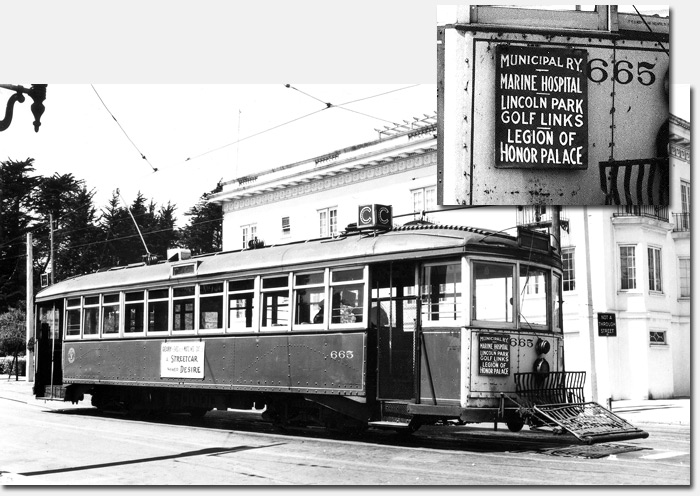
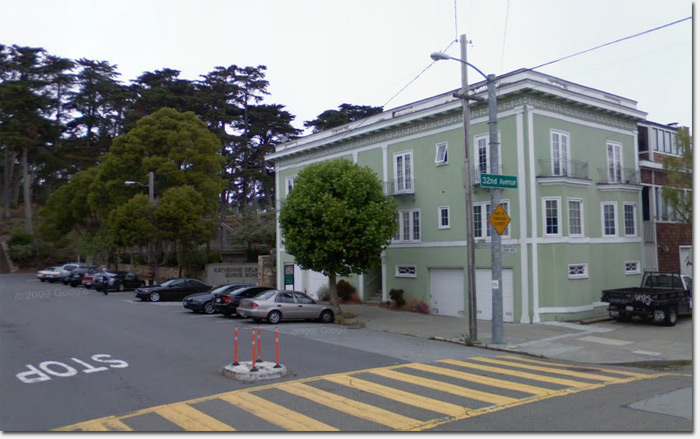
A today shot of the the intersection of 32nd Avenue & California where the streetcar was photographed.
Streetcar #665
A C California streetcar, eastbound on California at 32nd Ave. The vehicle itself is the former #265 from the Sutter line before the Market Street Railway and Muni merger in 1944.
The C was a pretty straight forward route, running from the Ferry Building along Market to Geary, west on Geary to 2nd Avenue, then north two blocks to California, terminating at 32nd and California (the carbarn was on the property at 32nd & Clement that will soon become a CVS Pharmacy and Fresh & Easy grocery).
Jack Tillmany dates the photo from 1949, probably between March and July. You’ll notice on the route sign it lists the Marine Hospital which is now the Presidio Landmark apartments inside the gate at 15th & Lake. It was originally a hospital for merchant seamen, later becoming the Public Health Hospital. All the locations listed on the sign were not direct stops, but could be reached with a short walk from the car’s stops.
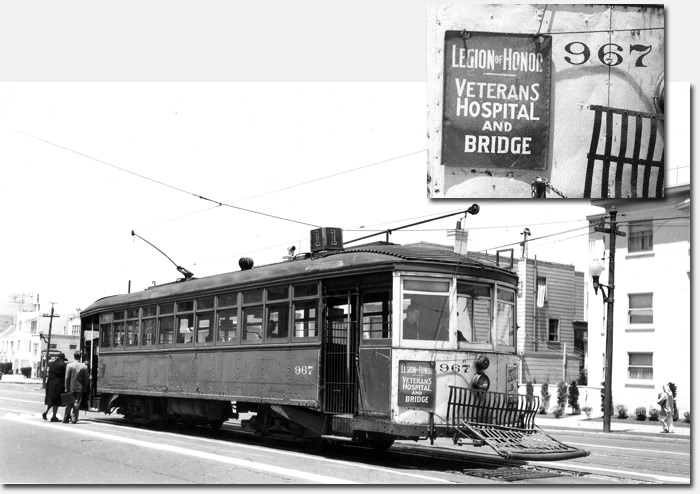
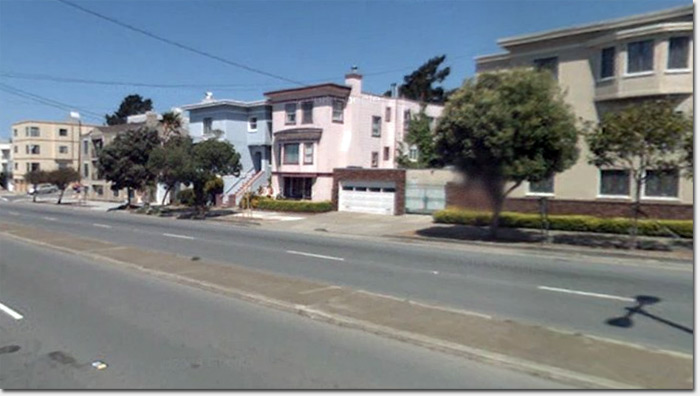
A today shot of the intersection of Geary & 37th Avenue where the streetcar was photographed.
The three stacked windows in the streetcar photo are on the building in the today shot
whose windows are obscured by the tree.
Streetcar #967
The photo of car 967 as a #1 streetcar was likely also taken in 1949, sometime between March and July. Tillman guesses it is either pictured on outer Geary (it ran from 33rd Avenue to 48th Avenue) or California somewhere between Parker and Arguello.
The #1 ran from the Ferry Building, up Market to Sutter, then west to Presidio Ave. where it turned north to California St. as far as Presidio Avenue, where it went a block south to Euclid. At Arguello, the #1 went the half block to Clement, then all the way out Clement to 33rd Ave, where it turned south to Geary, and followed Geary to Pt. Lobos, then to the waiting station above Sutro Baths. It was converted to a bus line on July 3, 1949.
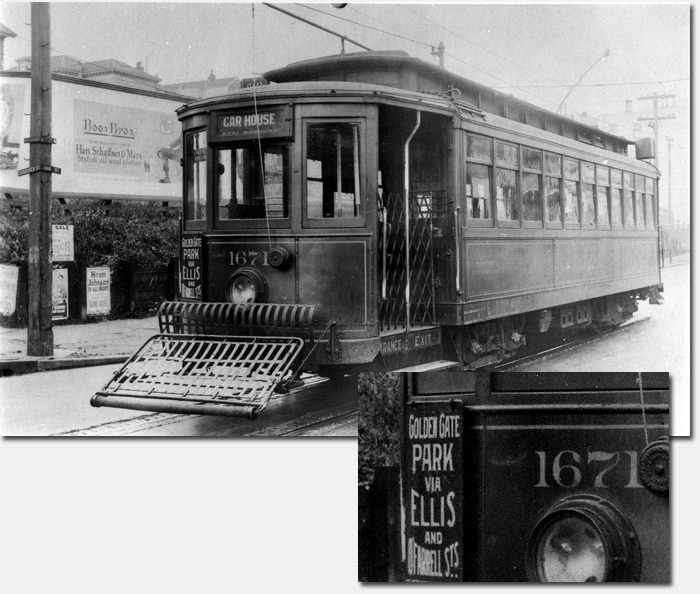
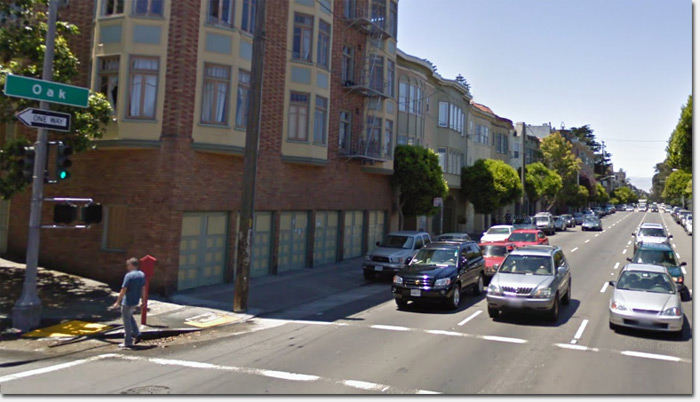
A today shot of the intersection of Oak and Broderick where the streetcar was photographed.
Streetcar #1671
#1671 was part of the post-quake order from the St. Louis Car Company, delivered in the Fall of 1906 and into 1907. They had a reputation as some of the smoothest running cars in the fleet. I think the one pictured is the old #20 car of the Market Street Railway Co. The photo was most likely taken in the 1920s; the car in the photo is parked outside its barn, which was Oak and Broderick.
The route from downtown started at the S.P. Depot at Third and Townsend, via Townsend, Fourth, Ellis, Hyde, O’Farrell (outbound, Ellis inbound), Divisadero, Oak (outbound, Page inbound) and ending at Stanyan/Golden Gate Park. So it never ran in the Richmond District, except for the first 10 years it ran across the park to the Richmond side.
The route started service on April 29, 1906, a little over a week after the flames were extinguished. It used to continue south along Stanyan, then turned on Lincoln Way almost to the beach, across the park to terminate at La Playa and Balboa. In 1916, they created the #7 line, which came out Haight and around the Park to the Beach, so the #20 was cut back to terminate at Stanyan.
I love these! I’d definitely pick the streetcars over MUNI 🙂
When you say you saw them at the flea market, does that mean they are prints for sale? Do you have contact information for the person selling them?
@Amy – It was a guy selling old 4×6 and 5×7 photos, these were mixed in with them. If you’re looking for something larger, I’d be happy to scan them at high resolution for you; you could them get them printed. Just drop me a line via the Contact Us page.
Sarah B.
So what are the scoops/cages/racks on the front of the street cars? Early bike racks? Luggage racks? Something to scoop pedestrians up so that they didn’t get run over?
@Bob – Someone else asked the same thing on Facebook. I’ll hit up John Freeman, see if he knows the answer…
I grew up in the Richmond District in the 1950’s and remember the last of the streetcars on Geary and Balboa. Not sure why they converted to buses in the Richmond and kept streetcars in the Sunset. Thanks for the pix.
In her book “We the People: A Story of Internment in America”, Mary Tsukamoto talks about loosing her leg when getting run over by a street car on Geary. So I guess that if they are people catchers, they didn’t always work so good.
Car 967 is just west of the intersection of Geary and 37th Avenue. The view is to the north. You are seeing the rear of the building on the northwest corner at right.
Great photos.
Right you are, Jonathan! I think I found the right view on Google Maps. The other one, car 665, is at the corner of 32nd Avenue and California. I’ll post some “today” images alongside.
I think the Richmond streetcars may have been removed to make way for the imminent arrival of BART… and we all know how that turned out.
Speaking of which, delete this if it’s out of line, but I’d like to encourage people to vote for Bert Hill for BART board. The current guy, James Fang, is a proponent of projects like the extension to Livermore and the Oakland Airport Connector, both of which are massively expensive (both construction and operation) and yet don’t promise a lot in the way of ridership (he had an article in the Richmond Review this month extolling Geary BART but he hasn’t actually done anything on it in his many, many years).
Bert Hill seems a little more sensible about the big projects and more focused on improving the service that exists. I think he’s also a lot more likely to get something going on Geary St.
More likely the streetcars were removed with the popularity and rapid rise of the automobile. This is likely the same reason that they removed the tracks on the lower deck of the bay bridge in favor of private vehicle traffic. It is ironic how a number of decades later, the pendulum is swinging back towards rail traffic. I guess it was a good idea afterall!
It has been said that the board of supervisors were “influenced” by oil and auto companies to remove street cars in favor of diesel buses. However, it’s Interesting that California and Fulton (McCallister) Street lines ran electric buses.
Well, sure, in a general sense, but if the question is “why the Richmond, and not the Sunset?” I’ve heard that BART is the explanation.
The route of the 1-California street car (privately operated) originally (see notes on car 967) ran from Ferry to the 48th-Point Lobos Station via Market, Sutter, Presidio, California, private right of way along Land’s End to the station.
On September 5, 1915, the franchise on California from 6th to 33rd was taken over by the city and the route became Ferry via Market, Sutter, Presidio, California, Sixth Avenue, Clement, and private right of way along Land’s End to the station. (The new Muni line ‘C’ ran from Ferry via Market, Geary, Second Avenue, Cornwall, California to terminal just past 32nd Avenue.)
On February 7, 1925, operation on the private right-of-way around Lands End ended due to a washout and the outer terminal became 33rd and Clement.
When the city bought out the Market Street Railway in 1944, the city extended the line to 45th and Geary.
In October, 1947, buses replaced street cars on evenings and Sundays. In July, 1949, the last 1 streetcar ran. In January 1951 trolley coaches replaced the buses with service on evenings and Sundays combined with the 3 Jackson line. From November, 1970, to December, 1972, buses replaced trolley coaches due to rewiring. In 1982, the 1 and 55 Sacramento lines were combined and service on Sutter was discontinued.
As for why the Sunset got to keep the L and N streetcar lines (but not the 7, 12, and 17 streetcar lines) and the Richmond lost the B, C, 1, 2, 5, and 31 streetcar lines, the reason lies with the tunnels. The Sunset and Twin Peaks Tunnels are too narrow for automobiles so they are retained for streetcars.
Thanks for the info.
A facebooker identified the thing on the front as an eclipse fender or “cow-catcher” as they were commonly called. Some info from Wikipedia (http://en.wikipedia.org/wiki/Pilot_%28locomotive%29):
In railroading, the pilot is the device mounted at the front of a locomotive to deflect obstacles from the track that might otherwise derail the train. In some countries it is also called cowcatcher or cattle catcher.
In addition to the pilot, small metal bars called life-guards, rail guards or (UK) guard irons are provided immediately in front of the wheels. They knock away smaller obstacles lying directly on the running surface of the railhead. Historically fenced-off railway systems in Europe relied exclusively on these devices and forwent the use of pilots, but this design is rarely used in modern systems.
Trams use in place of the pilot a device called a fender. Objects lying on the tram track get hit by a sensor bracket, which triggers the lowering of a basket shaped device to the ground preventing overrunning of the obstacles by dragging it along the road surface in front of the wheels.
In snowy areas the pilot has also the function of a snowplow.
Notice the “Roos Brothers” billboard in one of the photos? Sigh. that takes me back. And I only remember it after it had become “Roos-Atkins” — a really wonderful San Francisco men’s store.
The URL http://lightrailproducts.com/001-005/003.eclipse.fender.htm shows diagrams of the eclipse fender and offers a pair for $79.99. The website uses Muni car 7 to illustrate the fender. This photo shows car 7 as originally delivered with no side windows in both front sections – only the center section was glazed. Once reality set in, Muni glazed the entire cars.
Interesting description of the purpose of those fenders on that site. So they were focused on pedestrian safety. Perhaps MUNI could save itself millions in wrongful death suits by reinstalling them today.
These protective frames on streetcars were always called “cow catchers”, stolen from the similar contraption on trains. SF streetcars didn’t have fixed safety guards, but they were attached at on both ends of a streetcar, but would be folded up on the back. Most streetcars could be run either direction, so the “back” safety guard would be folded up. It was a scene on Market Street to see young macho guys who would sit on the top of the folded-up safety guard (cow catcher). The motorman on a streetcar had a throttle handle, that he took with him from the front to the back of a streetcar if he was going to activate the controls on the other end of the car. It was kind of like a throttle wrench, that would be used to move the controls.
The safety guards were supposedly going to protect pedestrians from being hit by a streetcar, but because the extended about 5 feet in front of the streetcar, they did provide a cushion if the streetcar were to hit a person, automobile, horse or wagon. None of these things were moving that fast in the early days, but as machines sped up, the cow catcher wasn’t that effective.
One of the posts talks about a girl loosing a foot or leg and how the safety provided wasn’t very successful in that case. What usually happened in that situation, was a person would slip while mounting or dismounting from a streetcar. There was little or no protection around the wheels of a streetcar near the steps. We had a girl in my neighborhood who lost a foot on the #31 Balboa streetcar in just that manner. So the cow-catcher would protect people or vehicles in a head-on collusion, but there was very little safety at the point where you stepped up or stepped down from the streetcar. If a person slipped and twisted, and the streetcar started up before checking that all passengers were clear, serious injury to a foot could occur.
There was some question about why the streetcar was eliminated and where within the City. The postwar years saw a great need across the country to “modernize” infrastructure. The streetcar was looked upon as being a relic of the early part of the 20th Century. It was limited to specific routes where rails ran, so provided little route flexibility. Most of the streetcar lines in San Francisco converted to buses in 1948-49. This was a period of rapid expansion of motor vehicles. Buses manufacturing paralleled auto manufacturing, but to a much less degree. The change from streetcar to bus for public transportation, was not limited to San Francisco. It happened across the country. It was also a time of extensive freeway construction throughout the State to accommodate the increased use of automobiles. Subway systems in major cites was something that happened in a much earlier time. The Metro in Washington DC area opened in 1976 and BART in the Bay Area opened in 1972.
The first Muni streetcar line, the B Geary held out until 1956 before it became a bus line. The Sunset District was served by two tunnels: West Portal and Sunset Tunnels. That is why the L, M & N lines were preserved. Tying into BART came much later. The J-Church also had it’s own tunnel that predates all this and it too tied into BART later. These were old streetcar lines, that later get renamed as Metro lines, but they really were conceived as streetcar lines to deal with difficult routes through SF hills, not around them.
I love street cars. and it was a lot cheaper to ride, may have been even free. Nice Cow catchers in front too.
Great Photos!,looking forward to doing my own Photoshoot in your hometown Soon!Take Care!
http://streetcarboy.blogspot.com/,Please visit my streetcarphoto-blog if you have a chance.